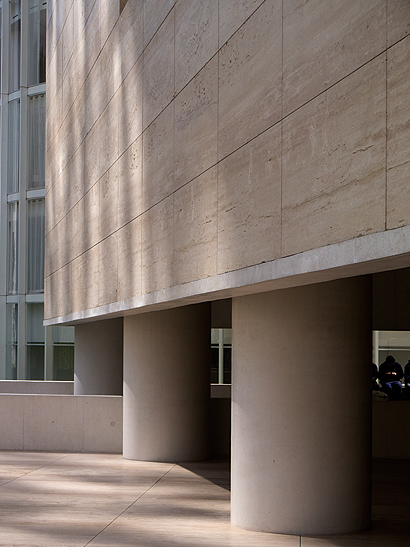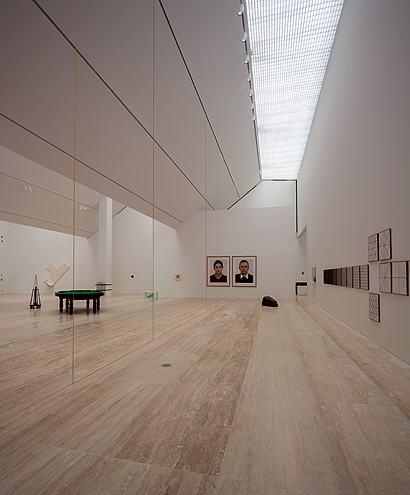|
David Chipperfield’s first project in Latin America is a crisply detailed, modernist gallery for the region’s largest private collection. Behind its travertine walls and sharp-toothed roof, it is also one of the most defiantly public buildings in Mexico City The industrial behemoth, the found space with its hangover of real production, has proved to be an almost irresistible draw to arts institutions over recent years. From the lofts of SoHo and the workshops of Shoreditch to the myriad power stations and factories in cities across the globe, industrial space with its functional nakedness and a memory of real life and economic usefulness engrained in its surfaces has become a default for art display. Mexico’s Jumex Foundation bucked the trend. Here was a stylish, cool, capacious art space inserted into a working industrial complex. A visit to the museum involved a curious journey through security checkpoints and past armed guards, steel vats of juice and huge delivery trucks laden with fruit. The visitor was confronted with the reality of production, with the origin of the fruit juice wealth that enabled Jumex to build up the finest private collection of contemporary art in Latin America. This was not the found industrial space of cliché, but a gallery made somehow more real by its location in the system of capital that is allowing contemporary art’s bubble to expand at such an explosive rate. Jumex has now, again, gone in the opposite direction to other institutions attempting to enhance their credibility with a move from bourgeois luxury to industrial chic. It is moving its prime operation from a factory buried deep in the freeways and favelas of Mexico City’s edgelands to an emerging retail and commercial development at the edge of the upmarket Polanco district. If the factory – with its scents of citrus and chilli, and the low-rise sprawl of the favelas and roadside businesses that surround it – could hardly be more redolent of Mexico City, its new situation is global brand bland. Its mix of elliptical commercial modernism, big-box retail and too-big plazas surrounded by traffic-clogged, uncrossable roads, could be anywhere, a place with no regard to climate, custom or colour. That context is complicated by the unavoidable iconic gesture: Fernando Romero’s remarkable Soumaya Museum, a sequin-clad squashed toadstool that lurks in the plaza like a futuristic fungus, part Paco Rabanne, part Future Systems, part Guggenheim, but mostly just bad. This museum, designed to house the collection of the world’s wealthiest man, Carlos Slim (Romero’s father-in-law), is certainly among the worst spaces I have ever seen for art – a place that sucks the life out of even the finest pieces in the collection and sucks the energy out of you before you get halfway up the ramp.
Detail of the travertine cladding The architect assigned to make a place for the Jumex collection in this placeless mush was David Chipperfield. Perhaps surprisingly (or perhaps not), Chipperfield’s brand of tasteful, stone-clad modernity slots in smoothly. His architecture may be minimal, but it has a robustness and a self-conscious monumentality that is easily able to compete with the surrounding, far bigger, icons. Museo Jumex’s appearance, though, is a little odd. My first impression was of a bigger branch of the Spanish department store chain El Corte Inglés. It has the determinedly modern air but also, with its travertine cladding, the respect for local materials that would make it appropriate in a historic Spanish city centre, but strange in a new development. Sitting on a raised plaza, each level is expressed in a corbel so that it flares out in stages as it rises and, with an extremely pronounced saw-toothed roof, it looks spiky and a little defensive. It doesn’t appear to be the most sociable of buildings, but as you come into its confines it opens up, becomes friendlier and, in fact, becomes that rather rare thing for Mexico City: a resolutely public building. The plinth on which it sits (which lifts it above the traffic) becomes a series of terraces, one of which functions as a kind of plaza, another as an outdoor cafe. It is rarely cold here and the shade is welcome, even on a November morning. Three huge timber doors pivot open to make the ground floor a kind of extension of the outdoor terrace rather than the other way round. The ground floor does not feel like a lobby. Chipperfield seems to have an aversion to the increasingly all-consuming foyer space, a ground floor that creates the kind of supposedly seamless institutional non-place blend of airport, mall, waiting room and college. In his recent extension to the St Louis Museum of Art, he similarly avoided the impression of a lobby space, so the visitor is immediately plunged into the displays with no discernible institutional buffer zone. I sit down on the cafe terrace to chat to Chipperfield about the new building, while he seems distracted that security guards are keeping the huge doors shut, ruining the openness of the ground floor. “It’s the classic museum problem,” he says. “In architecture, the spaces of movement are more expressive and photogenic. So there’s been a sacrifice of static space for dynamic space. The museum used to be a closed box and now it has become a leisure destination.”
The travertine stairs are lined in black steel And which one is this, museum or leisure? “We wanted two levels of more dynamic space, with a direct connection between inside and outside,” he replies. “There is this ground floor space” – he gestures towards the doors (now opened after he had a word with the guards) – “and there is a glass box above, a programmed space that is almost like a mini-Turbine Hall.” Ah, the Turbine Hall. Museo Jumex is a museum founded in the heart of a factory, its revenue coming directly from production, on the site of a former brewery, its roof bristling with super-sharp saw teeth. Surely then, there has been some effort here to recreate something of the industrial idea that lies at the heart of so much contemporary architecture for art? “No, not really,” he says. Bang. There goes my central thesis. Although it might have made an easy analogy, Chipperfield is probably right. This building is a blend of other typologies. Its corbelled layers and stony presence make it look a little like a castle keep. That first floor room the architect was talking about – the “mini-Turbine Hall” – is really more like a Miesian glass box (right down to the full-length drapes) contained in a stone case. And the gallery spaces, one a blank black box, the other that striking saw-toothed crown, really don’t owe much to industry. But that top gallery is nevertheless quite something. Rather than the conventional form of a box with a serrated top, the sharp angle of the roof lights cut deep into the space, looking almost dangerous, as if you could cut yourself on them. The curious ceiling, which impinges on the interior, means this never becomes the neutral white box of art gallery lore. Instead it has a kind of dynamic as the roof pulsates, dips and soars above you. The north light that filters in, meanwhile, is stripped of its intensity so the even, almost translucent glow that permeates the gallery is more Nordic than Latin. The circulation space is something very different again. Here, en route between spaces, the travertine stairs are lined in black steel, with sharp detailing and invisible junctions. They are dark and plain, their coarseness given by the grain of the materials alone; otherwise, this is as finely detailed a volume as you will see anywhere. But then, Mexico’s own modernism is very fine – a slew of young(ish) architects are producing houses and commercial buildings as good as anywhere in the world. Chipperfield himself makes the point that this is the first major institutional building in the city to be designed by an international architect. Does that knowledge, I wonder, put a special onus on the designer? “The question is,” he replies, “could we make this building more vital, more civic than it was at its previous location? This is a quasi-public building so we had to ask, ‘What is public space?’ We had to make it so that you didn’t just enter it through the lobby, but that there are a series of thresholds. The first, where you enter the building, is where you step onto the travertine, you step up from the street. We are still toying with the idea of having the ticket desk outside the building – the climate here is so good you can play with the location of the threshold. It’s only crime that’s an issue.” The second threshold, Chipperfield explains, is the interior – that in-out lobby. “[Mexican architect Luis] Barragán used that inside-outside idea so well, eroding the notion of the threshold and we wanted to enjoy that too,” he says. It’s good to hear the architect referring to Mexican tradition. He is gushing about the workmanship and appears to have enjoyed working here. He also refers to some of the peculiar Mexico City insecurities I have heard others mention. “There is a sense of the questions: ‘Are we international?’, ‘Are we world class?’,” he says. And he’s right. Eugenio Lopez, scion of the Jumex empire and founder of the Jumex collection, has spent a fortune on this opening and its lavish accompanying parties. Despite the quality and breadth (and collectability) of contemporary Mexican art (Orozco, Alÿs, Ortega, Kuri, Lozano-Hemmer and the others), there is a nervousness about the status of the art scene, perhaps in comparison with the established US. But there is also a discernible nervousness about the public nature of architecture. This, along with its spangly Soumaya neighbour, is a public building of a particular sort. It is the kind of building built to house a private collection that forms the basis of many of the best museums in the US. But it is not a public building in the real sense. The qualms about that private/public status have, perhaps ironically, led to more thinking about the nature of public space and the boundaries between the plaza, the lobby, the gallery, the terrace and so on. The result is a better building with a more fluid interaction with the space and the city that surrounds it.
The saw-tooth roof allows light to enter the top-floor gallery |
Words Edwin Heathcote |
|
|




















